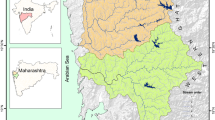Abstract
An analysis of the drainage network of a part of Sivasagar district, Assam, India, is undertaken to reveal the role of neotectonic activity of the area. A number of fluvial geomorphic anomalies have been identified in the area. A prominent annular drainage anomaly is displayed by the major rivers—the Dikhu, Jhanzi, Namdang, Dorika and Disang, whose courses are carved in response to the ongoing tectonic deformation in the area. This study reveals that the development of topography and drainage system of the study area have been influenced by active subsurface geological structures. Formation of paleochannels, compressed meanders, reticulate streams, swamps, sagging of grounds, stream alignments, lineaments, knick points and abandonment of rivers as well as development of smaller drainage anomalies also substantiate the active nature of the subsurface structures.






Similar content being viewed by others
References
Akhtar, S. M., Chakrabarti, S., Singh, R. K., Moulik, S. R., Bhattacharya, J., & Singh, H. (2009). Structural style and deformation history of Assam & Assam Arakan Basin, India: from Integrated Seismic Study. Adapted from oral presentation at AAPG Annual Convention, Denver, Colorado, June, 7–10, 2009.
Building Material & Technology Promotion Board (BMTPC) (2003). Vulnerabilty atlas - 2nd edn; peer group, MoH & UPA; Seismic zones of India IS: 1983-2002, BIS, GOI, Seismotectonic atlas of India and its environs, GSI, GOI.
Bull, W. B. (2007). Tectonic Geomorphology of mountains. Oxford: Blackwell Pub. 316pp.
Chansarkar, R. A. (1981). Change in river course in certain parts of Brahmaputra. GSI Miscellaneous publication, 46, 85–92.
Clark, M. K., Schoenbohm, L. M., Royden, L. H., Whipple, K. X., Burchfiel, B. C., Zhang, X., et al. (2004). Surface uplift, tectonics, and erosion of eastern Tibet from large-scale drainage patterns. Tectonics, 23. doi:10.1029/2002TC001402.
Dasgupta, A. B. (1977). Geology of Assam Arakam region. Mining and Metallurgy Society of India Quarterly Journal, 49, 1–54.
Goswami, B. G., Bisht, R. S., Bhatnagar, A. K., Kumar, D., Pangtey, K. L., Mittal, A. K., et al. (2005). Geochemical characterization and source investigation of oils discovered in Khoraghat–Nambar structures of the Assam-Arakan Basin, India. Organic Geochemistry, 36, 161–181.
Holbrook, J., & Schumm, S. A. (1999). Geomorphic and sedimentary response of rivers to tectonic deformation: a brief review and critique of a tool for recognizing subtle epeirogenic deformation in modern and ancient settings. Tectonophysics, 305, 287–306.
Howard, A. D. (1967). Drainage analysis in geologic interpretation: a summation. Amercian Association of Petroleum Geologists Bulletin, 51(11), 2246–2259.
Kunte, S. V. (1988). Geomorphic analysis of Upper Assam Plains and Adjoining areas for hydrocarbon exploration. Journal of the Indian Society of Remote Sensing., 16(1), 15–28.
Mathur, L. P., & Evans, P. (1964). Oil in India (p. 85). New Delhi: International Geological Congress, 22nd session.
Narula, P. L., Acharyya, S. K., Banerjee, J. (2000). Seismotectonic Atlas of India and its Environs. Special Publication, 59. Geological Survey of India, pp. 1–40.
Obruchev, V. A. (1948). Osnovnye cherty kinetiki i plastiki neotektonik. Izv Akad Nauk Ser Geol, 5, 13–24.
Ouchi, S. (1985). Response of alluvial rivers to slow active tectonic movement. Geological Society of America Bulletin, 96, 504–515.
Pahari S., Singh, H., Prasad, I. V. S. V & Singh, R. R. (2008). Petroleum Systems of Upper Assam Shelf, India. Society of Petroleum Geophysicist, India. Geohorizons, December, 14–21.
Roy, T. K. (1975). Drainage analysis in the upper Assam Valley. Indian Journal of Earth Sciences., 2, 39–50.
Saha, K.K., Dave, H.D., Mitra, D.D. (2006). Study of Tectonic Elements of Punjab Plains from satellite imagery, drainage network and gravity anomalies. 6th International Conference & Exposition on Petroleum Geophysics “Kolkata 2006”, 43–48.
Sarma, J. N., & Basumallick, S. (1984). Drainage analysis of the areas around the Burhi Dihing river catchment India. Indian Journal of Earth Science, 11, 79–86.
Schumm, S. A., & Galay, V. J. (1994). The River Nile in Egypt. In S. A. Schumm & B. R. Winkley (Eds.), The variability of large Alluvial Rivers (Am, pp. 75–100). NY: Soc. Civil Engineers Press.
Schumm, S. A., Dumont, J. F., Holbrook, J. M. (2002). Active tectonics and alluvial rivers. Cambridge University Press. 292pp.
Valdiya, K. S. (1999). Why does river Brahmaputra remain untamed? Current Science, 76, 1301–1303.
Vulnerability Atlas of India (2006) First Revision. BMPTC.
Acknowledgment
The authors are grateful to Dr. P. G. Rao, Director, North East Institute of Science and Technology, Jorhat, for according the permission to carry out the research and publish this paper.
Author information
Authors and Affiliations
Corresponding author
About this article
Cite this article
Sharma, S., Sarma, J.N. Drainage Analysis in a Part of the Brahmaputra Valley in Sivasagar District, Assam, India, to Detect the Role of Neotectonic Activity. J Indian Soc Remote Sens 41, 895–904 (2013). https://doi.org/10.1007/s12524-013-0262-7
Received:
Accepted:
Published:
Issue Date:
DOI: https://doi.org/10.1007/s12524-013-0262-7



